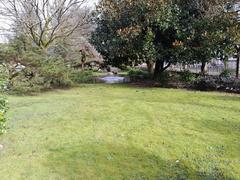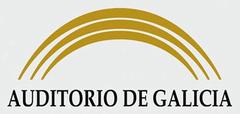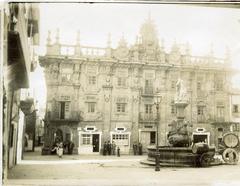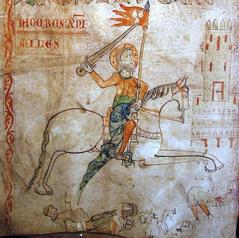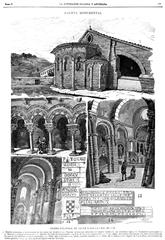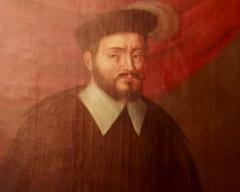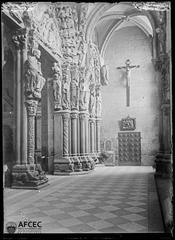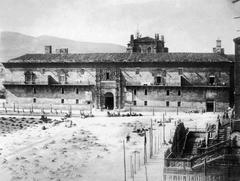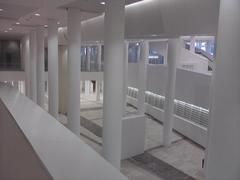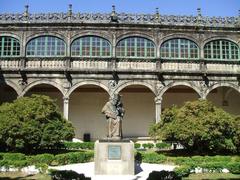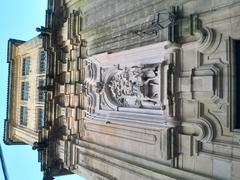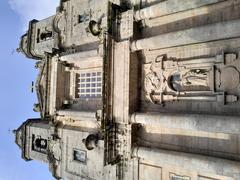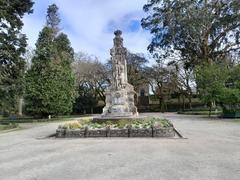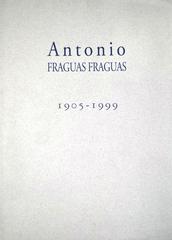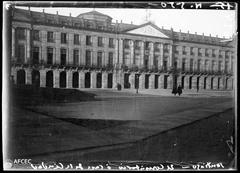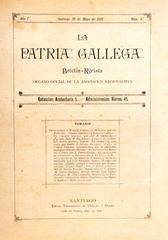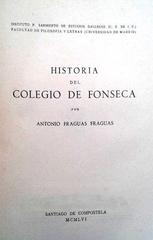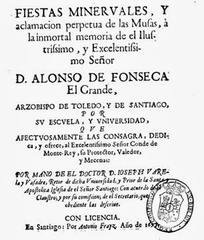
Visiting the Convent of San Domingos de Bonaval: Complete Guide to History, Architecture, and Visitor Experience
Date: 03/07/2025
Introduction
Nestled on the slopes of Monte de Bonaval just outside Santiago de Compostela’s ancient city walls, the Convent of San Domingos de Bonaval stands as a testament to Galicia’s spiritual, architectural, and cultural legacy. Established in the early 13th century, this Dominican convent has evolved from its Romanesque and Gothic roots through a dramatic Baroque transformation, ultimately serving today as the Museo do Pobo Galego—a vibrant center for Galician ethnography. This guide offers a detailed and structured overview of the convent’s history, architectural highlights, cultural significance, and essential visitor information, including hours, tickets, accessibility, and nearby attractions. Whether you are a history enthusiast, architecture lover, or cultural traveler, the Convent of San Domingos de Bonaval is an unmissable stop on your Santiago de Compostela itinerary (Spotting History; Museo do Pobo Galego; Santiago de Compostela Tourism).
Table of Contents
- Early Foundations and Medieval Origins
- Growth, Patronage, and the Late Middle Ages
- Baroque Transformation and Architectural Flourishing
- The Pantheon of Illustrious Galicians
- The Museo do Pobo Galego: Cultural Preservation
- Visiting Information: Hours, Tickets, Accessibility
- Navigating the Convent: Key Areas and Exhibitions
- Visitor Amenities and Practical Tips
- Frequently Asked Questions (FAQ)
- Conclusion & Call to Action
- Sources and Further Reading
Early Foundations and Medieval Origins
The Convent of San Domingos de Bonaval was founded in the early 13th century, traditionally attributed to St. Dominic de Guzmán, the founder of the Dominican Order. Documentary evidence dates its establishment to around 1228, during a time when Santiago de Compostela was a major pilgrimage destination (es.wikipedia). Its strategic location outside the medieval walls, near the Porta do Camiño, positioned it as a point of welcome and spiritual respite for pilgrims arriving via the Camino de Santiago (Wikipedia).
The earliest surviving architectural elements are Romanesque, visible in the granite masonry and semicircular arches. By the late 13th and early 14th centuries, Gothic influences began to dominate, featuring pointed arches, ribbed vaults, and tall, narrow windows that illuminate the church’s basilica layout (ilovecompostela.com).
Growth, Patronage, and the Late Middle Ages
The convent flourished under the patronage of the House of Altamira in the 15th century, solidifying its status as a center of religious and social life. Papal authorization allowed the burial of prominent laypeople within the convent, making it the resting place for leading Galician families such as the Moscoso and Castro lineages (es.wikipedia). The church, constructed primarily in the 14th century, houses significant Gothic tombs and reflects a harmonious blend of Romanesque solidity and Gothic verticality (Spain.info).
Baroque Transformation and Architectural Flourishing
By the end of the 17th century, much of the medieval convent had deteriorated, prompting a comprehensive Baroque reconstruction led by architect Domingo de Andrade under Archbishop Antonio de Monroy. Andrade’s work defined the convent’s current appearance, most notably the striking Baroque façade adorned with coats of arms and a central niche featuring St. Dominic. Fruit garlands and heraldic symbols evoke the convent’s ties to Galicia’s aristocracy (es.wikipedia).
The architectural masterpiece of the site is the triple spiral (helical) staircase, ingeniously designed by Andrade. Unique in Spain, this staircase features three independent spirals within a single shaft, allowing people to ascend or descend simultaneously without crossing paths—a marvel often likened to the double helix at France’s Château de Chambord (ilovecompostela.com).
Baroque influences also permeate the cloister and interior chapels, designed with elaborate ornamentation, gilded altarpieces, and sculptures. The Renaissance cloister, attributed to Rodrigo Gil de Hontañón, further enriches the complex with its blend of classical columns and decorative motifs (Caminosantiagocompostela.com).
The Pantheon of Illustrious Galicians
A highlight of the convent is its function as the Pantheon of Illustrious Galicians (Panteón de Galegos Ilustres), located in a side chapel of the church. This mausoleum honors prominent figures in Galician culture, including poet Rosalía de Castro, artist and politician Castelao, cartographer Domingo Fontán, sculptor Francisco Asorey, and others. This secular pantheon underscores the convent’s ongoing role in shaping Galician identity (es.wikipedia; ilovecompostela.com).
The Museo do Pobo Galego: Cultural Preservation
Since 1976, the convent has housed the Museo do Pobo Galego (Museum of the Galician People), a leading institution dedicated to preserving Galicia’s ethnographic and cultural heritage. Exhibits showcase traditional crafts, maritime history, rural life, and regional costumes. The museum also features a library, archives, and spaces for temporary exhibitions, lectures, and workshops, fostering cultural exchange and community engagement (museos.xunta.gal; Museo do Pobo Galego).
Visiting Information: Hours, Tickets, Accessibility
Opening Hours:
- Tuesday to Saturday: 10:00 AM – 7:30 PM
- Sundays and Public Holidays: 10:00 AM – 3:00 PM
- Closed Mondays, and on January 1, May 1, December 24, 25, and 31 (Museo do Pobo Galego).
Ticket Prices:
- General Admission: €3–€5
- Reduced Admission (students, seniors, groups): €1.50–€3
- Free entry for children under 18, residents of Santiago, and on Sundays or special cultural days.
Tickets can be purchased at the museum entrance or online (museos.xunta.gal). Free admission is available on Sundays, though these periods tend to be busier.
Accessibility:
- Most areas are wheelchair accessible, with ramps and elevators. Some historic sections, such as the triple spiral staircase, may not be accessible to all visitors. Accessible restrooms are available, and visitors with mobility needs are advised to contact the museum in advance.
Guided Tours:
- Available in Spanish, Galician, and with advance booking, in English. Tours provide deeper insights into history, architecture, and exhibitions.
Navigating the Convent: Key Areas and Exhibitions
- Baroque Façade: A striking entrance that reflects the convent’s 17th-century transformation.
- Triple Spiral Staircase: Baroque engineering marvel—photography is encouraged.
- Church of San Domingos de Bonaval: Gothic-Baroque interior, Pantheon of Illustrious Galicians, and notable tombs.
- Renaissance Cloister: Peaceful arcaded walkways with a central garden.
- Museo do Pobo Galego: Permanent and temporary exhibitions on Galician culture, rural and seafaring life, and traditional crafts.
- Bonaval Park: Adjacent public park with panoramic views and green spaces, once part of the convent’s grounds.
Tip: Allocate 1.5–2 hours to explore the convent, museum, and gardens fully.
Visitor Amenities and Practical Tips
- Gift Shop: Regional crafts, books, and souvenirs available near the entrance.
- Cafés/Restaurants: No on-site café, but many options nearby.
- Wi-Fi: Free Wi-Fi throughout the museum.
- Photography: Permitted except in designated areas; avoid flash during services or in sensitive spaces.
- Accessibility: Ramps and elevators in most areas; check in advance for specific needs.
- Language: Staff commonly speak Spanish and Galician; English spoken at ticket desk and on tours.
- How to Get There: Located at Rúa de San Domingos de Bonaval, s/n, easily walkable from the Cathedral. City buses (lines 1, 5, C11) serve the area. Parking is limited.
- Nearby Attractions: Cathedral of Santiago, Mercado de Abastos, Museo de Arte Contemporáneo (CGAC), Alameda Park.
Frequently Asked Questions (FAQ)
Q: What are the visiting hours?
A: Tuesday to Saturday: 10:00–19:30; Sundays and holidays: 10:00–15:00; closed Mondays.
Q: How much do tickets cost?
A: General admission €3–€5; discounts for students, seniors, and groups; free for children under 18 and on Sundays.
Q: Is the convent accessible for wheelchairs?
A: Most areas are accessible; some historic sections may be challenging.
Q: Are guided tours available in English?
A: Yes, advance booking is recommended for English-language tours.
Q: Can I buy tickets online?
A: Yes, via the official museum website.
Q: What other sites are nearby?
A: The Cathedral of Santiago, Mercado de Abastos, CGAC, and Bonaval Park are all within walking distance.
Conclusion & Call to Action
The Convent of San Domingos de Bonaval offers a layered journey through Galicia’s spiritual, architectural, and cultural history. From its medieval origins and Baroque masterpieces such as the triple spiral staircase, to its present-day role as the Museo do Pobo Galego and the Pantheon of Illustrious Galicians, the site embodies the region’s evolving identity.
Plan your visit by checking the latest hours and ticket details. Enhance your experience with the Audiala app for guided tours and insider tips, and follow us on social media for updates on special events and local culture. Embark on your discovery of Santiago de Compostela’s heritage at this remarkable landmark.
Sources and Further Reading
- Convent of San Domingos de Bonaval, Spotting History
- Convento de Santo Domingo (Bonaval), Wikipedia (es)
- Convent of San Domingos de Bonaval, Wikipedia (en)
- Convent of San Domingos de Bonaval, Spain.info
- Church and Convent of San Domingos de Bonaval, ilovecompostela.com
- Museo do Pobo Galego Official Website
- Santiago de Compostela Tourism
- Santiago de Compostela Ultimate Visitors Guide, Caminosantiagocompostela.com
- Museo do Pobo Galego, Xunta de Galicia
- Galicia Tourism, Convent of San Domingos de Bonaval







